With 30 June approaching, now is the perfect time to get your financial affairs in order. We have compiled a list of items that should be high priority for everyone.
Remember, 30 June falls on a Monday this year, so it is particularly important to plan ahead to ensure any pre-30 June transactions are completed well in advance. Timing is everything!
Concessional contributions (pre-tax)
The current annual concessional cap is $30,000. Concessional contributions include employer contributions, salary sacrificed amounts, and personal contributions claimed as personal deductions. These contributions are subject to a 15% tax rate.
For high-income earners – individuals earning $250,000 or more – an additional 15% tax applies on top of the standard 15%.
Clients should review their concessional contributions and taxable income for this financial year to determine if making additional contributions is beneficial. Additionally, it is worth considering the potential for a carry-forward concessional contribution strategy, as discussed below.
Starting from 1 July 2025 the Super Guarantee (SG) rate will increase to 12% however the concessional cap will remain the same.
Carry-forward concessional contributions
Since 1 July 2018, any unused amounts in an individual’s concessional contributions cap can be carried forward on a rolling five-year period if the individual has a total superannuation balance under $500,000 at the end of the previous 30 June.
For example, if David had made concessional contributions of $10,000 in each of the previous five financial years, and his total superannuation balance as at 30 June 2024 was $200,000, he would be eligible to make a concessional contribution of $112,500 in the 2024–2025 financial year. This amount includes his unused concessional caps from the prior five years, in addition to the standard cap for 2024–2025.
This strategy is particularly advantageous if taxable income was higher than average during the year, possibly due to an asset sale. Clients should check MyGov to determine their eligibility for this strategy.
Non-concessional contributions (post-tax)
The annual limit for non-concessional contributions is $120,000 if an individual’s total superannuation balance is below $1.9 million as at 30 June 2024.
The bring-forward rule allows eligible members to contribute up to three years of non-concessional contributions ($360,000) in one year. To qualify, members must not have triggered the bring-forward rule in the past two financial years and must have a total superannuation balance below $1.66 million as at 30 June 2024.
Individuals with a member balance between $1.66 million and $1.78 million can utilise part of the bring-forward rule.
For example, James, aged 58, is starting to plan for retirement. He has $500,000 in cash in his name and a total superannuation balance of $800,000. James decides to use the bring-forward rule to contribute $360,000 to superannuation as a non-concessional contribution in the FY24-25, aiming to invest in the share market. After this, he cannot make further non-concessional contributions for the next two financial years.
From 1 July 2025, the non-concessional contributions cap will remain at $120,000. However, the general transfer balance cap will increase from $1.9 million to $2 million. This change means individuals with a total superannuation balance of up to $2 million may still be eligible to make non-concessional contributions. The bring-forward thresholds will also increase accordingly.
As always, it’s important to seek professional financial advice before making any contributions.
Division 296 – $3 million super tax proposal
As widely reported and discussed since the election, the Div296 proposal aims to cap tax concessions on balances exceeding $3 million by imposing an additional 15% tax on the unrealised growth of these balances, effective from 1 July 2025. The $3 million threshold is not indexed and applies per member.
Given the Treasurer’s comments since the election and the inclusion of the tax revenue in budget estimates, it is becoming increasingly likely that the Government will proceed with the implementation.
For those impacted, potential strategies may include transferring assets out of superannuation into alternative tax structures, equalising member balances to keep each individual balance below the $3 million threshold or simply maintaining the current arrangements.
While there is considerable uncertainty regarding the outcome of this proposal, individuals who may be impacted should start considering their options to be best prepared.
Superannuation contribution work test
The work test is still a requirement for anyone over age 67 wishing to make a concessional contribution to superannuation before 30 June. To satisfy the work test, an individual must be gainfully employed for at least 40 hours during a consecutive 30-day period in the same financial year as the contribution is made.
Work test exemption (WTE)
Individuals aged 67 to 74 may be able to make additional voluntary contributions for up to 12 months from the end of the financial year in which they last met the work test. They will need to meet the following criteria:
- Their total superannuation balance was under $300,000 on 30 June in the previous financial year.
- They met the work test in the previous financial year.
- No WTE contributions were received in the previous financial year.
For example, Steven aged 68, retired on 30 June 2024 with a total superannuation balance of $150,000. On 12 August 2024, he sold his investment property to realise the capital gains during the year he was not working, thus lowering his taxable income. Following this, he used the proceeds to make both a concessional and non-concessional contribution before 30 June 2025.
As non-concessional contributions no longer require the work test to be met, the work test exemption only applies to personal concessional contributions.
Superannuation pension payments
Pension payments and minimum and maximum limits should be reviewed. Accurate figures must be obtained for each member as penalties may be imposed for over or underpayment.
The standard and revised minimums are as follows:

The maximum transition to retirement pension remains at 10%.
For example, Jane, aged 68, had an SMSF valued at $480,000 on 1 July 2024. Her usual minimum is $24,000 (5%) which she generally elects to draw as a single payment in June.
Superannuation contribution splitting
The pension transfer cap on funds in the tax-free pension phase has made it more important than ever for couples to maintain even account balances. Superannuation splitting allows a member with a higher account balance to transfer up to 85% of their concessional contributions to their spouse (the 15% contributions tax is deducted before splitting).
The receiving spouse must be less than their preservation age or between their preservation age and 65 and not retired. The splitting application should be completed in the financial year immediately after the financial year in which the contribution was made or in the same financial year if the account is going to be closed.
Consider whether you have met a condition of release
Anyone who has reached age 60 should be aware of the potential conditions of release that would allow them access to their superannuation and commence a tax-free Account-Based Pension. As part of an end-of-financial year review, determining if a condition of release is met could provide significant benefits.
The most common conditions of release include retiring post-preservation age and reaching age 65 regardless of work status. However, a little-known condition is ceasing an employment arrangement on or after the age of 60. This condition is even met if you have two employment arrangements and only end one while the other continues.
Government co-contribution
Anyone with an adjusted taxable income of less than $60,400 can take advantage of the government co-contribution, however, the maximum benefit of $500 begins to taper down when their taxable income exceeds $45,400.
The government co-contribution is not available to individuals who exceed the non-concessional contribution cap or the total superannuation balance cap of $1.9 million.
Spouse contribution
If an individual has an assessable income of less than $40,000 then their spouse can make a non-concessional contribution on their behalf and claim a tax offset. The maximum offset is $540, where your spouse’s assessable income is $37,000 or less. The offset reduces as the receiving spouse’s assessable income increases above $37,000 and is phased out at $40,000.
Get in touch
If you would like to discuss any of these strategies further, please contact your Bell Potter adviser.
LEARN MORE
Our Technical Financial Advice team, in conjunction with a Bell Potter adviser can help you create a road map to achieve your financial goals, no matter where you are today. Whether you are looking for one-off advice or ongoing advice, our team can assist.
Get in touch with us to set up a complimentary initial appointment over the phone or in person across Australia.
